Hydroxypropyl Methylcellulose (HPMC) An Overview
Hydroxypropyl methylcellulose (HPMC) is a widely used polymer in a variety of industries, including pharmaceuticals, food production, and construction. This semi-synthetic derivative of cellulose is valued for its unique properties and versatility. In this article, we will explore the composition, characteristics, applications, and advantages of HPMC, along with its impact on different fields.
Composition and Properties
HPMC is created through the chemical modification of cellulose, a natural polymer obtained from plant cell walls. The process involves both hydroxypropyl and methyl etherification reactions, which introduce hydroxypropyl and methyl groups into the cellulose structure. This modification results in a polymer that is soluble in water and has unique functional properties.
The primary characteristics of HPMC include its viscosity, gel-forming ability, film-forming properties, and biodegradability. Depending on the degree of substitution and molecular weight, HPMC can exhibit a wide range of viscosities. This variability allows manufacturers to tailor the polymer to meet specific needs in various applications.
Applications of HPMC
1. Pharmaceuticals HPMC is extensively used in the pharmaceutical industry as an excipient in the formulation of tablets, capsules, and controlled-release systems. It acts as a binder, viscosity-increasing agent, and stabilizer, influencing the release profile of active pharmaceutical ingredients (APIs). Additionally, HPMC is used to create films for pill coatings, enhancing the drug's stability and patient compliance.
2. Food Industry In the food sector, HPMC serves as a thickener, emulsifier, and stabilizer. It is commonly found in gluten-free products, where it provides the necessary texture and consistency that gluten would typically offer. HPMC is also used in sauces, dressings, and dairy products, improving mouthfeel and preventing the separation of ingredients.
hydroxypropyl methyl cellulose hpmc

3. Construction The construction industry benefits from HPMC's properties as a water-retaining agent and an additive in cement-based materials. When included in mortar and plaster, HPMC enhances workability, adhesion, and water retention, leading to improved performance and durability of building materials.
4. Cosmetics HPMC is utilized in cosmetic formulations for its thickening and film-forming properties. It enhances the stability and texture of creams, lotions, and gels, providing a smooth application and feel.
Advantages of HPMC
The use of HPMC brings several advantages. Its water solubility allows for easy processing and incorporation into various formulations. HPMC is also non-toxic and physiologically inert, making it a safe choice for applications in food and pharmaceuticals. Furthermore, its biodegradable nature aligns with the growing demand for environmentally friendly materials in various industries.
Another significant benefit is its ability to form thermally reversible gels. This property enables HPMC to be used in hot or cold processing conditions, expanding its usability in diverse formulations.
Conclusion
Hydroxypropyl methylcellulose (HPMC) is a multifunctional polymer that plays a crucial role across different industries. Its unique chemical structure and properties allow it to serve various functions, from acting as a binder in pharmaceuticals to a thickener in food products and an additive in construction materials. As industries continue to evolve, the demand for versatile and sustainable ingredients like HPMC is likely to grow.
With its range of applications and benefits, HPMC exemplifies how chemical modifications of natural polymers can lead to critical advancements in product formulations. Its role in developing innovative products aligns with the ongoing trends toward sustainability and efficiency, ensuring that HPMC will remain relevant and essential in the years to come. Whether in improving patient outcomes, enhancing food quality, or contributing to construction efficiency, HPMC is a key player in modern manufacturing and formulation practices.
-
A Comprehensive Guide to Methyl Ethyl Hydroxyethyl Cellulose: Applications and Industry InsightsNewsNov.24,2025
-
Understanding Methyl 2 Hydroxyethyl Cellulose: Uses, Benefits & Industry InsightsNewsNov.24,2025
-
Hydroxyethyl Methyl Cellulose HEMC: Industrial Uses, Benefits & Future TrendsNewsNov.23,2025
-
HEMC Cellulose: Versatile & Sustainable Industrial Polymer | YoungcelNewsNov.23,2025
-
Methyl Hydroxyethyl Cellulose: Versatile Building Block for Industry & SustainabilityNewsNov.23,2025
-
CAS 9032 42 2: Understanding Polyvinyl Alcohol's Impact on Industry & SustainabilityNewsNov.22,2025




